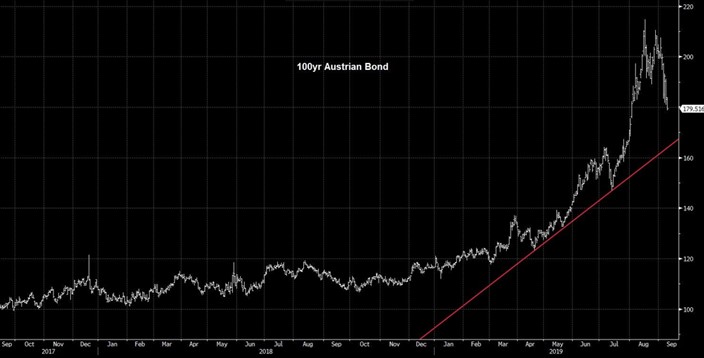| What happened? Bond yields around the world rose, meaning bond prices fell. Far and fast. Now higher bond yields probably don’t sound so bad. Higher interest rates is just what the doctor ordered for yield starved investors, right? You could finally earn some income from your bonds. The trouble is the other side of the same coin. Falling bond prices dish out capital losses to anyone already holding the bonds. Austria’s famous, or should I say infamous, 100-year bond is a nice example. Because it has such a long maturity, the price movements are more intense. The bond’s price doubled from 2018. But in the last few weeks it crashed back down. | 
| | Source: Julian Brigden on Twitter |
That’s a whopping capital gain and then loss someone is feeling right now. On a ‘safe’ government bond. Now, if you hold a bond to maturity, the capital loss doesn’t apply. You get paid back the par value, which is fixed. So who cares? Well, first of all, not many people plan on holding the bond for 100 years… But, more importantly, the price of the bond in the chart above is €179. The par value is €100. That means the holder of the bond is booking in a €79 loss between now and when it matures. And the piddly coupon of 1.2%, or €1.20 per year, in the meantime, isn’t enough to make up for that loss. Not compared to alternatives, once you factor in inflation, and whatever else could happen in the next 96 years… Austria’s 100-year bond holders will probably be repaid in deutschmarks by the time the bond comes due. At least, that’s what historically happens to currency unions in Europe. But focus on the nature of the proposition. People evidently bought these bonds as a speculative bet, hoping to sell them on to a greater fool before the baked in loss comes due in 96 years’ time. Sounds like a recipe for a plunge, if you ask me. Speaking of the deutschmark, bond prices didn’t just move in Austria this week. They spiked all over the place. The Guardian estimates that the stock of negative yielding bonds went from $17 trillion to ‘just’ $15 trillion in a matter of days. We’re talking big losses on the price of bonds. But the move to more sensible yields and interest rates has hardly begun. The German government now has to pay interest to borrow money for 30 years. But the rest of the yield curve is still negative, meaning the government can still get paid to borrow for shorter time periods. The UK government’s 10-year gilt yields almost doubled to 0.666%. That’s a big move for speculators. But it’s still incredibly low. Over in Denmark, a bank is still offering mortgages with negative interest rates. We’re far from back to normal. Even if it’s just a blip, what triggered the recent turnaround? I’m sure you can guess what the UK’s Guardian newspaper points to. Brexit… But I blame the Germans. Negative bond yields in places like Germany are surprisingly fragile. I’ve been warning my readers here in the UK that yields would only hold up, or in this case down, for as long as governments don’t actually take advantage of them. Your credit rating only holds up for as long as you don’t borrow too much. So taking advantage of a good credit rating for the sake of it ruins that credit rating. From which point on, you haven’t got a good one to take advantage of. It’s a cake you can’t eat. The same idea applies to the German government, with the interest rate moving in real time to reflect any change. So what did the Germans do? A few weeks ago they tried to actually sell bonds at negative rates. But the demand was insufficient — people don’t want bonds that pay less than nothing. That was the warning of what was to come. Then, a few days ago, the German government began to mention the word ‘stimulus’. At first it just featured in questions foreign journalists asked. Then the German government denied that word was on the table. Then the local German journalists began to ask questions about ‘stimulus’ too. Then the opinion columns featured the word. Next ‘sources suggested’ that ‘plans leaked’, and now it’s a question of ‘how much stimulus’ is on the table. And the bond market reacted viciously to the change ever since. Austria’s bonds tumbled, Germany’s 30-year bond hit positive yields, the UK’s 10-year yield doubled and even the US’ Treasury yields spiked almost as much as on Trump’s election. All it took was a whisper of ‘stimulus’. Confirming the bond market is incredibly fragile to actually being tapped for funding. With bond prices tumbling if governments want to use it to stimulate the economy, what does that suggest for the coming months? Governments’ attempts to save their economies from a recession could crash their financial systems by making bond prices tumble. The question is, how long until we see the consequences filter into the part of the financial world you actually pay attention to? The stock market. Again, it could take years for the reality of falling bond prices to hit other markets. But I doubt it’ll be long. You’ve been warned. | Until next time, |  | | Nick Hubble,
For The Daily Reckoning Australia |
| 